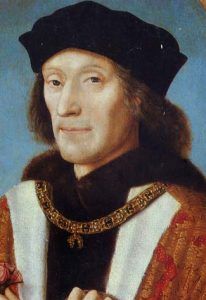 |
For a number of centuries the Crown relied on the Exchequer to be its basis of finance. The Exchequer had two functions – to receive and pay out money and to audit accounts. The Exchequer employed many people some of whom had the primary function of trying to stop embezzlement and fraud. Though there must have been some corrupt officials, the punishment for crimes committed in the Treasury were so severe that this along put off many. However, the primary weakness of the Exchequer was the simple fact that it was very slow in what it did. Audits could take years to complete and this meant that the Crown was always going to be short of money. It was this weakness that Henry VII resolved to change. Henry decided to build on the Chamber that had been introduced by the Yorkist family. This was a more informal set-up than the Exchequer and it was a relatively new institution that had no operating processes set in stone. The Chamber’s flexibility in approach was its main strength. The system was a favourite of Edward IV who had seen it at work in the day-to-day running of the great estates of the senior nobility. Edward used the King’s Chamber to run his finances and men who worked in this were personally appointed by the king. When Henry VII succeeded in 1485, his main concern was survival. Therefore he reverted to using the slow-moving Exchequer. But Henry’s worsening financial well-being made him change course. In the reign of Richard III, royal estates had brought in £25,000 a year. By 1486, this had declined to £12,000. Clearly Henry had to do something.
Henry knew that to survive as king, he needed the money to finance an effective royal army. Therefore, he had to modernise the way royal income was collected. In 1487, Henry decided to restore the Chamber to its former position “as the most important institution of financial administration.” (Caroline Rogers). At the end of the century, revenue from royal estates was in excess of £100,000 a year. The Chamber dealt with nearly all aspects of royal income (except custom dues and the accounts of the sheriffs). Those appointed to the Chamber were trusted by Henry – but they also had financial acumen. It was ironic that Henry developed the system implemented by the man he defeated at the Battle of Bosworth – Richard III. A number of the men who worked in the Chamber were also men who had worked for the Yorkists.
The Chamber effectively took charge of the national treasury. Its success led to the reform of Henry’s household. The most important section of the royal household was the Privy Chamber. This took over responsibility for Henry’s personal expenditure, a task that the Chamber had previously done. The chief officer of the Privy Chamber was the Groom of the Stool. The man who held this office was second only to the Treasurer of the Chamber. The Privy Chamber was to play an important part in the history of the Tudors and many ministers who served the likes of Henry VIII and Elizabeth I rose from its ranks.
The Treasurer of the Chamber became the most important financial figure for Henry. Two men held this post under Henry VII – Sir Thomas Lovell (1485 to 1492) and Sir John Heron (1492 to 1509). However, Heron remained in the post under Henry VIII until 1521. Henry worked alongside both men, even to the extent of checking the accounts that they had already gone over. Henry personally signed each page of accounts at the bottom – presumably to make it clear to both Lovell and Heron that he had personally gone through the accounts to check them. Both men owed their elevated position to Henry, so it was very unlikely that they would do anything to betray his trust. Regardless of this, Henry still felt the need to scrutinise his accounts.
While historians have been quick to recognise Henry’s financial ability, he did have expert advisors in this field. His most trusted advisor was Sir Reginald Bray, the Chancellor of the Duchy of Lancaster. Bray had worked for Henry’s mother, Elizabeth of York. But he came to Henry’s attention when it became very clear that he was highly skilled in managing the most valuable of the king’s estates. The War of the Roses had made it very difficult to successfully administer the royal estates. Bray took up the challenge with great success. While his official position may not have been high on any social/political ladder, Bray’s power lay in the fact that he had the ear of the king and they met with great frequency. Bray worked closely with Heron – neither seems to have viewed the other as a rival. Both men seem to have been driven by one desire – to make the king’s estates as financially efficient as was possible. In this they were successful.
Henry VII had two forms of revenue – ordinary and extraordinary. Ordinary revenue came in every year from crown lands, custom dues, feudal taxes etc. This was seen as a royal right. Extraordinary revenue was granted in the form of a tax by Parliament when requested by the king. The most usual reason for this was to fight a war. However, the king also had access to ‘feudal aid’ – money that was raised if the king was ever captured in battle and held for ransom. ‘Feudal aid’ was also given when a rich subject – such as a noble – granted the king money in times of emergency or was also money granted to the king as part of a favourable peace treaty.
Related Posts
- Many in England believed that the succession of Henry VIII would usher in a less austere era than the one Henry VII had ruled…